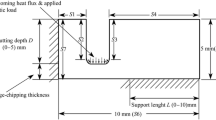Abstract
In EDM drilling, the accumulation of debris is the main factor leading to abnormal discharges and process instability, which prevent the processing of microholes with a high aspect ratio. To fabricate microholes with an ultrahigh aspect ratio, bubbles produced by an electrochemical reaction were applied to assist electrical discharge machining (B-EDM) in tungsten materials. The mechanism and machining performances of the B-EDM method were investigated. The results showed that bubbles produced by electrochemical reaction on both the surface of the electrode and the workpiece prevented the accumulation of debris at the bottom of the hole, which improved machining stability. This process is effective in enhancing drilling performance in deep microholes by improving such parameters as the material removal rate, electrode tool wear, longitudinal section topography, and achieved aspect ratio. Experimental results showed that the processing time and electrode wear of B-EDM were approximately one third those of EDM in the processing of 20 mm through-holes. A hole with a diameter of 0.22 mm and depth of 120 mm was successfully fabricated by B-EDM on tungsten within 130 min.













Similar content being viewed by others
References
Biermann D, Bleicher F, Heisel U, Klocke F, Möhring HC, Shih A (2018) Deep hole drilling. CIRP Ann 67(2):673–694
Wang MH, Zhang YB, He ZW, Peng W (2016) Deep micro-hole fabrication in EMM on stainless steel using disk micro-tool assisted by ultrasonic vibration. J Mater Process Technol 229:475–483
Yan BH, Wang AC, Huang CY, Huang FY (2002) Study of precision micro-holes in borosilicate glass using micro EDM combined with micro ultrasonic vibration machining. Int J Mach Tools Manuf 42:1105–1112
Diver C, Atkinson J, Helml HJ, Li L (2004) Micro-EDM drilling of tapered holes for industrial applications. J Mater Process Technol 149:296–303
Dong SL, Wang ZL, Wang YK, Zhang J (2017) Micro-EDM drilling of high aspect ratio micro-holes and in situ surface improvement in C17200 beryllium copper alloy. J Alloy Compd 727:1157–1164
Ekmekci B, Sayar A (2013) Debris and consequences in micro electric discharge machining of micro-holes. Int J Mach Tools Manuf 65:58–67
Li GD, Natsua W, Yu ZY (2018) Study on debris behavior and its influence on EDM characteristics in deep micro-hole machining. CIRP Ann Manuf Technol 68:578–581
Zhao WS, Wang ZL, Di SC, Chi GX, Wei HY (2002) Ultrasonic and electric discharge machining to deep and small hole on titanium alloy. J Mater Process Technol 120:101–106
Eberhard B, Sumet H (2009) Orbital electrode actuation to improve efficiency of drilling micro-holes by micro-EDM. J Mater Process Technol 209:1826–1834
Natsu W, Maeda H (2018) Realization of high-speed micro EDM for high-aspect-ratio micro hole with mist nozzle. Procedia CIRP 68:575–577
Goiogana M, Sarasua JA, Ramos JM (2018) Ultrasonic assisted electrical discharge machining for high aspect ratio blind holes. CIRP Ann Manuf Technol 68:81–85
Yu ZY, Zhang Y, Li J, Luan J, Zhao F, Guo D (2009) High aspect ratio micro-hole drilling aided with ultrasonic vibration and planetary movement of electrode by micro-EDM. CIRP Ann 58(1):213–216
Liew PJ, Yan JW, Kuriyagawa T (2014) Fabrication of deep micro-holes in reaction-bonded SiC by ultrasonic cavitation assisted micro-EDM. Int J Mach Tools Manuf 76:13–20
Ferraris E, Castiglioni V, Ceyssens F (2013) EDM drilling of ultra-high aspect ratio micro holes with insulated tools. CIRP Ann Manuf Technol 62(1):191–194
Wang J, Han FZ (2014) Simulation model of debris and bubble movement in consecutive-pulse discharge of electrical discharge machining. Int J Mach Tools Manuf 77:56–65
Kunieda M, Tohi M, Ohsako Y (2003) Reaction forces observed in pulse discharges of EDM. Int J Electrical Machining 8:51–56
Author information
Authors and Affiliations
Corresponding author
Additional information
Publisher’s note
Springer Nature remains neutral with regard to jurisdictional claims in published maps and institutional affiliations.
Rights and permissions
About this article
Cite this article
Qingfeng, Y., Pengyue, W., Zhiqiang, Q. et al. Electrical discharge drilling assisted with bubbles produced by electrochemical reaction. Int J Adv Manuf Technol 109, 919–928 (2020). https://doi.org/10.1007/s00170-020-05709-9
Received:
Accepted:
Published:
Issue Date:
DOI: https://doi.org/10.1007/s00170-020-05709-9



